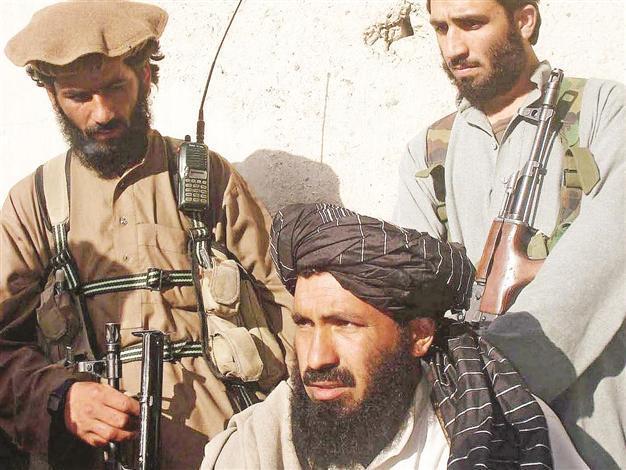US drone kills senior Taliban commander
PESHAWAR

Pakistani warlord Mullah Nazir (C) was the main militant commander in South Waziristan. Nazir was understood to be close to the al-Qaeda-linked Haqqani network. AFP photo
U.S. drone strikes have killed a prominent warlord who had sent insurgents to fight in Afghanistan, as well as nine other militants in Pakistan’s tribal belt.Mullah Nazir was the main militant commander in South Waziristan, part of the tribal zone where militants linked to the Taliban and al-Qaeda have bases. He is one of the highest-profile drone victims in recent years.
Pakistani officials said a U.S. drone had fired two missiles at his vehicle in the Sar Kanda area of Birmil in South Waziristan, and that five of his loyalists including two senior deputies were also killed.
Two of his influential deputies, Atta Ullah and Rafey Khan, were among those killed, officials said. Nazir was understood to be close to the al-Qaeda-linked Haqqani network, a faction of the Afghan Taliban blamed for some of the most high-profile attacks in Kabul and elsewhere in Afghanistan in recent years.
His death could prove to be a contentious issue between Washington and Islamabad, which is believed to have struck a nonaggression pact with Nazir ahead of the Pakistani military’s 2009 operation against militants in South Waziristan.
Militants under Nazir’s command focused their attacks on American forces in Afghanistan, earning the militant leader the enmity of the U.S. But Pakistan’s military viewed Nazir and militant chiefs like him as key to keeping the peace internally because they do not attack Pakistani targets.
Possible impacts of death
Analysts were divided on the impact that his death would have on Pakistan and on the U.S.-led war against an 11-year insurgency in neighboring Afghanistan. Pakistani author and expert on the tribal belt, Imtiaz Gul, suggested there would be little fallout for Pakistan, which is trying to assist efforts by the Western-backed Kabul government to broker a peace deal. “The Americans and Afghans suspected Mullah Nazir of sheltering and hosting Arab al-Qaeda operatives,” Gul said.
“They (the U.S. and its coalition partners) want to eliminate whatever elements are left in the border regions to minimize the threat that Arab al-Qaeda poses to U.S. forces in Afghanistan,” said Saifullah Khan Mehsud, executive director of the FATA Research Center, adding that his death could unleash chaos given that Nazir tried to contain the Pakistani Taliban and keep Wazir tribes and militant groups united.
“If he is dead then it is a big problem for the Wazir tribe, it is a big problem for the Pakistani army,” said Mehsud.
“I don’t know what the U.S. was thinking when they decided to hit him, because why would you make things difficult for your most important ally in the region? That would create chaos in that region,” he added.
The use of drones has increased substantially under President Barack Obama. According to the Long War Journal, which tracks drone strikes, there were 35 strikes in Pakistan during 2008, the last year President George W. Bush was in office.
In 2009, that number went up to 53 and then shot up to 117 in 2010, the year with the most drone strikes in Pakistani territory. Last year, the U.S. carried out 46 strikes, and the latest strike that killed Nazir was the first of 2013.
The program has killed a number of top militant commanders over the past year, including al-Qaeda’s then-No. 2, Abu Yahya al-Libi, who died in a drone strike in June in North Waziristan.
















